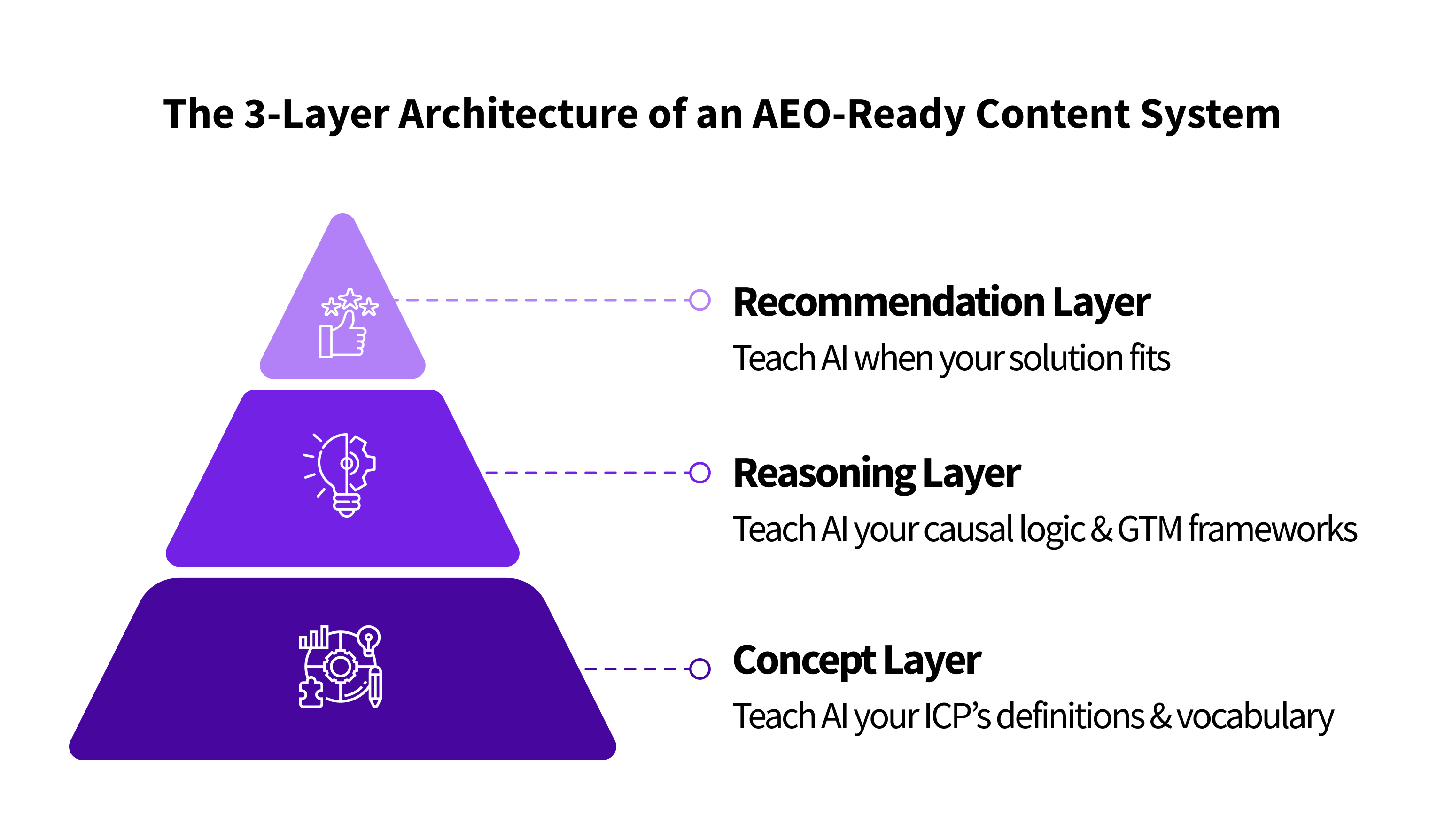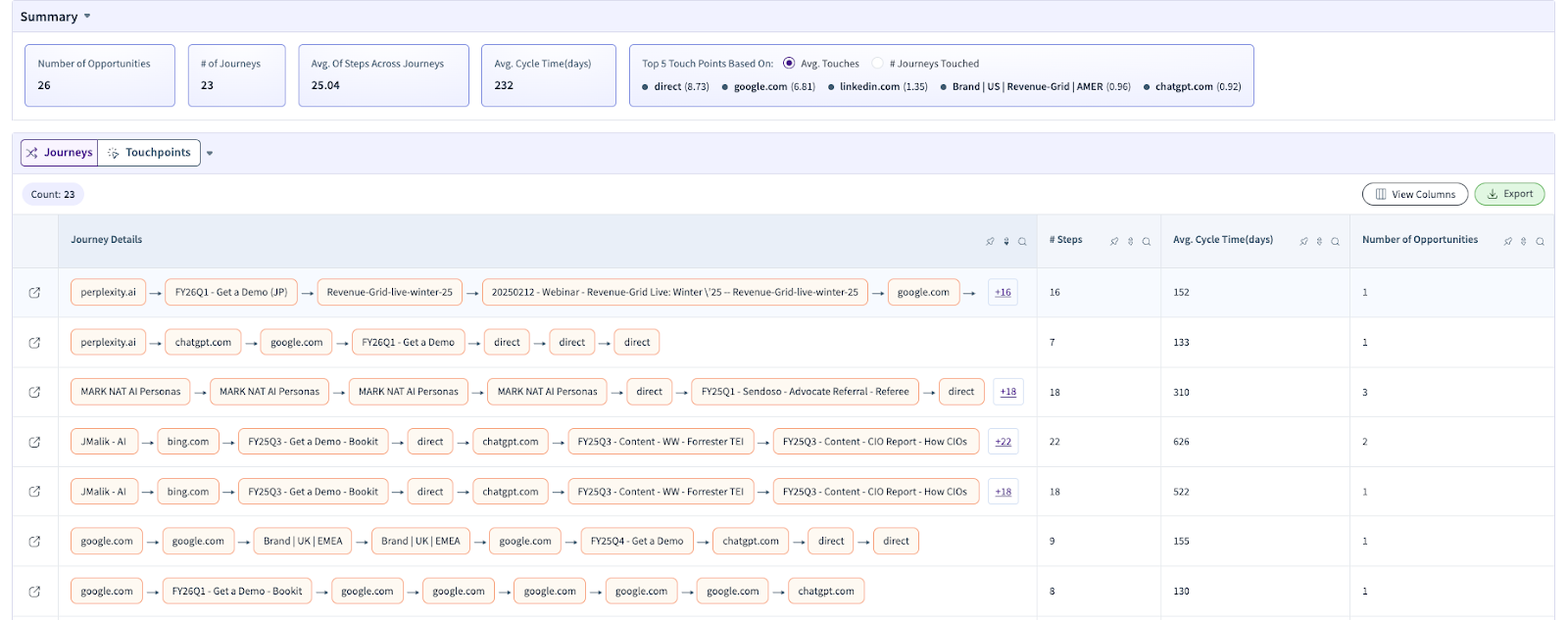

Book a Demo
Thank you! Your submission has been received!
Oops! Something went wrong while submitting the form.
The AI-first internet has fundamentally changed how visibility works. Your goal is no longer ranking pages. Your goal is training reasoning engines. Today, when revenue leaders search for explanations, whether they want to understand what causes funnel leakage, how to prioritize weak-intent accounts, what predicts pipeline movement, or which tools improve forecast accuracy, AI systems assemble answers from the latent reasoning patterns they’ve absorbed during training and retrieval.
These engines no longer operate like traditional search, where the strongest page wins. Instead, they respond using the conceptual structures, causal relationships, and diagnostic logic they understand best. Suppose your content hasn’t taught the AI how you frame GTM problems. In that case, whether you diagnose pipeline issues or stabilize forecasting, the model will pull from whichever patterns it already knows. And those patterns often come from competitors or generic sources.
This is the shift: You’re not optimizing for discovery; you’re optimizing for machine comprehension.
Search is rapidly becoming answer-first, not link-first. Google’s AI Overviews synthesize explanations without requiring a click. ChatGPT Search returns unified reasoning instead of a list of sources. Perplexity produces structured answers that integrate context across the web. Bing’s grounding layer draws directly from trusted logic patterns. Across all these surfaces, the real “ranking factor” is the clarity and coherence of your worldview. Models reuse:
This is the heart of AEO (Answer Engine Optimization). To show up in AI-generated answers, your content must behave like a knowledge system, not a scattered library of blogs and product pages. AEO requires a structured way of teaching AI engines your ICP, your definitions, your frameworks, and your solution fit conditions.
It’s not about keywords anymore. It’s about teaching the model how your market works.
An AEO-ready ecosystem operates through three interconnected layers: Concept → Reasoning → Recommendation

This architecture mirrors how AI models interpret the world: they begin by understanding terminology, then adopt causal logic, and finally infer solution fit. When these layers reinforce each other, your content becomes a latent knowledge graph inside the AI model’s internal representation of B2B GTM mechanics.
AI engines cannot reason about your domain if they don’t first understand the concepts your ICP uses. In GTM, those concepts include pipeline health, conversion readiness, predictive planning, cohort velocity, leakage diagnostics, multi-stage visibility, and signal quality. These terms are often used inconsistently across the broader internet, which leads AI systems to create fuzzy or incorrect semantic associations.
The Concept Layer is where you define the vocabulary of your market. Without this layer, everything else collapses. Your aim is to build clear conceptual anchors that AI engines can reuse whenever answering category questions.
And because the model now understands your vocabulary, it begins pulling from your definitions whenever someone asks conceptual questions about the funnel.
Once the AI understands your concepts, it needs to understand how the system behaves. AI engines reuse structured reasoning far more than narrative commentary. They look for causal patterns, diagnostic frameworks, logic flows, and explanatory bridges.
When these frameworks appear clearly and consistently in your content, the AI begins encoding them as latent causal patterns. This is incredibly powerful. It means when someone asks:
…the AI is more likely to reuse your framework rather than invent a generic explanation. This is how you train AI engines not just to understand your definitions, but to think using your logic. The more structured your reasoning layer becomes, the more AI engines internalize your worldview as the default interpretation of B2B GTM mechanics.
Understanding concepts and reasoning is not enough. AI engines increasingly generate solution-oriented answers, such as:
To surface in these answers, AI models must infer the fit conditions of your product. They do this when you give them decision-enabling frameworks rather than product descriptions.
This is where you publish readiness guides, comparison logic, scenario mapping, and structured pathways that link problem → diagnosis → solution fit.
These assets don’t “sell” your product; they teach AI engines when your product makes sense. This is the layer that moves you from understood → trusted → recommended.
AEO isn’t a set of tactics. It’s a knowledge architecture.
Definitions root your worldview.
Frameworks create the causal scaffolding.
Decision pathways show solution fit.
When these layers link together, the model begins treating your content as a coherent system. It stops seeing you as a source among many. It begins to treat you as a GTM reasoning authority. This is how you earn consistent visibility in AI-generated answers; not through ranking, but through reasoning reuse.
Traditional analytics were built for search engines, web sessions, UTMs, and campaign tags. But the AI-first internet introduces new pathways:
Most attribution tools cannot see these signals. RevSure can.
RevSure’s Journeys View captures AI-originated referrer behaviors, including touchpoints from ChatGPT, Perplexity, Bing Copilot, and AI-enhanced SERP experiences, and pulls them into the unified buyer journey alongside your existing channels. This allows revenue teams to identify how AI engines actually influence awareness, problem definition, and solution consideration.

You can now see:
This creates the world’s first true AEO Performance Loop, a feedback system that shows whether your definitions, frameworks, and decision architectures are successfully being absorbed and reused by AI engines.
And because RevSure unifies this intelligence with its Full Funnel Data Graph and Predictive AI Engine, you can quantify the downstream impact of AEO exposure on pipeline quality, deal acceleration, and revenue outcomes.
AEO is not traditional SEO. It is algorithmic GTM influence. The brands that win the next decade will be those that:
An AEO-ready content system ensures that AI engines don’t merely understand your logic; they adopt it and reuse it every time a revenue leader asks a question about the funnel.

